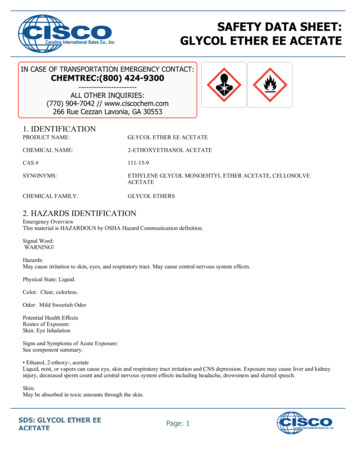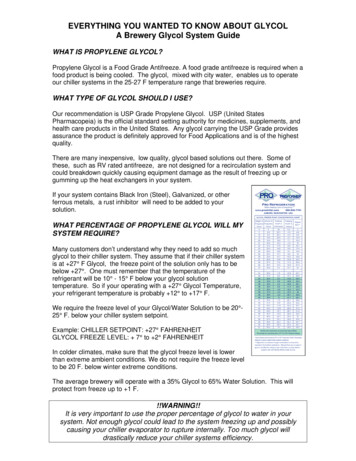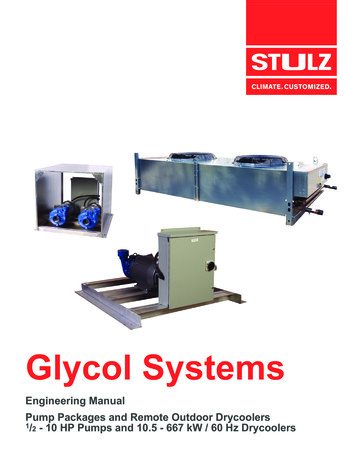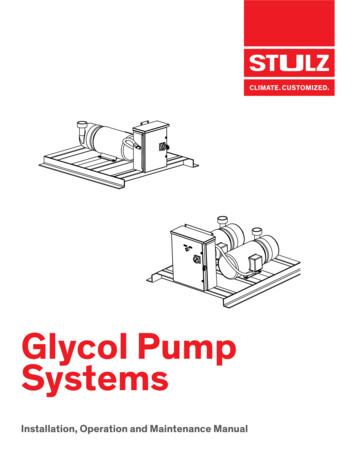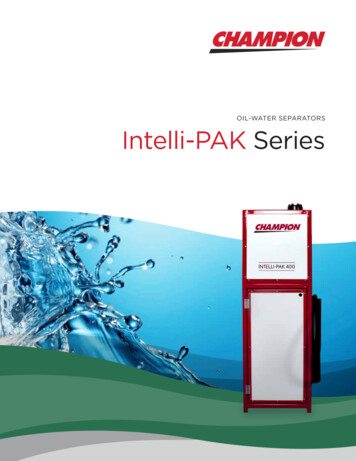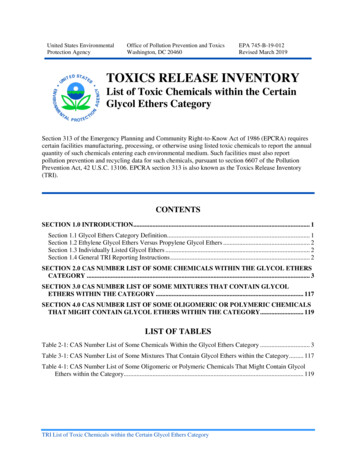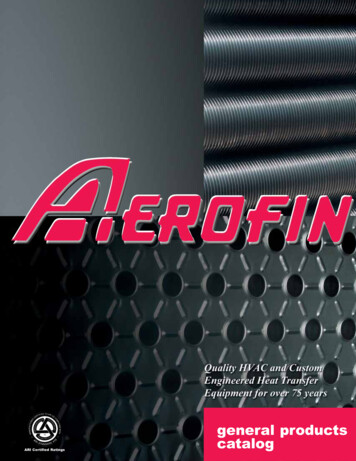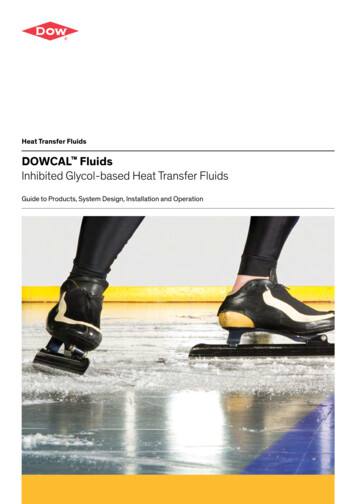
Transcription
Heat Transfer FluidsDOWCAL FluidsInhibited Glycol-based Heat Transfer FluidsGuide to Products, System Design, Installation and Operation
DOWCAL FluidsTable of ContentsIntroduction to DOWCAL 100, DOWCAL 200 and DOWCAL N FluidsPage 4Advantages of DOWCAL Fluids Page 5Selecting the Right DOWCAL Fluid Page 6Typical Applications for DOWCAL Fluids Page 8Corrosion Protection Capabilities Page 11Using DOWCAL Fluids Page 13– Material Compatibility Page 13– Storage of DOWCAL Fluids Page 14– Fluid Analysis RecommendationsPage 14– Fluid Dilution Requirements Page 14– Disposal of Solutions of DOWCAL Fluids Page 14– Fluid Flammability and Fire HazardsPage 14– Facts on Food ContactPage 15– Fluid Handling Page 15– System Design Page 15– Preparing New Systems for Use of DOWCAL FluidsPage 15– Preparing Existing Systems for Use of DOWCAL FluidsPage 15Physical Properties of DOWCAL Fluids Page 163
DOWCAL FluidsBreweries use DOWCAL N Fluid to control fermentation and wort tanks temperature.DOWCAL 100, DOWCAL 200 and DOWCAL N FluidsHigh Performance Inhibited Glycol-based Heat Transfer FluidsDOWCAL heat transfer fluids are clear, ethylene or propyleneglycol-based liquids formulated with our signature corrosioninhibitors for optimum system performance. They are optimalsolutions if the freezing point of water is not low enough toallow its use in certain applications. Typically diluted with Trademark of The Dow Chemical Company (“Dow”) or an affiliated company of Dow4water, DOWCAL fluids offer reduced viscosity, increased heatcapacity and thermal conductivity, and take advantage of theexcellent heat transfer properties of water over a broad rangeof temperatures.
DOWCAL FluidsAdvantages ofDOWCAL HeatTransfer FluidsAre all heat transfer fluids the same?Absolutely not. Heat transfer fluidsmust address a wide range of oftenvastly different process-specific needs.Selection of the wrong product for agiven application may cause damagewhen the system is filled. Corrosion orgasket decomposition can lead to leaks,lack of performance and damage toproperty at the worst case. Majorequipment overhauls may be requiredto repair system damage. Consideringthe potential high price of systemrepairs – and the potential cost ofproperty and other damage in the eventof a system failure and leakage dueto ruptured components, it pays tocarefully select a heat transfer fluid.Dow offers a full range of DOWCAL heat transfer fluids – including bothethylene glycol- and propylene glycolbased fluids – to meet your specificsystem requirements. When you choosea DOWCAL fluid, you can be confidentit will provide long-lasting protectionand performance without jeopardizingthe integrity of the equipment inwhich it is used. Corrosion Protection—DOWCAL fluids are formulated with carefullychosen corrosion inhibitors to provideprotection to the metallic parts ofprocess equipment, therefore improvingprocess efficiency and reducingmaintenance costs. DOWCAL 100 andDOWCAL 200 in particular are veryefficient at protecting aluminum (seeadditional details on page 11 and 12). Compatibility—DOWCAL fluids setthe industry standard for compatibility.The fluid formulations will not affectmost plastics and metals, minimizingthe potential for gasket decompositionin process equipment.Ground source heat pumps use DOWCAL 100 and DOWCAL 200 fluids to help provide efficient heating and cooling in private andindustrial buildings while reducing energy use. Long-lasting Performance—DOWCAL fluids are also long-lasting and can beoperated for many years in properlymaintained systems. Their specialcorrosion inhibitor package supportshigher temperature operationcompared to alternative technologies. Sustainable—DOWCAL fluids arenitrite, borax, and CMR (carcinogenic,mutagenic, and reprotoxic) free. Formulated for MaximumConvenience— DOWCAL 100 andDOWCAL 200 can be diluted withlocal tap water supplies whendemineralized water is not available.(See additional details on page 14). Use in Regulated Industries –DOWCAL N is suitable for use in foodplants (see additional details regardingfood contact on page 15 of this brochure).Expert Technical SupportAs a Dow heat transfer fluids customer,you have direct access to our industryleading heat transfer expertise,including our in-depth and highlydiversified application experience.Dow heat transfer specialists will helpyou select the exact fluid you require,then work with you to properly installand optimize fluid operation for bestresults. Contact us as indicated on theback of this brochure to learn moreabout our services and to beginworking with our experts on yoursuccessful heat transfer project.Additional ResourcesFLUIDFILE software from Dow isavailable to assist in the design ofheating and cooling processes and inthe selection of the best DOWCAL fluidfor specific applications. FLUIDFILE provides physical properties and fluiddynamics for any temperature rangeand any DOWCAL /water mixing ratio.Combined with the information inthis guide, FLUIDFILE can help youachieve optimum heat transfer systemperformance. Visit www.DOWCAL.comto download the FLUIDFILE Software.5
DOWCAL FluidsSelecting the Right DOWCAL FluidDOWCAL fluids are used successfullyin a wide range of applications, fromrenewable energy and HVAC systems,to chemical, pharmaceutical andfood processing. Your choice of fluidwill depend both on where it willbe used and your operatingtemperature requirements. DOWCAL 100 heat transfer fluid is anethylene glycol-based fluid especiallysuitable for use in the pharmaceuticaland specialty chemical industry toheat and cool reactors, but alsofor heating, ventilating, and airconditioning (HVAC) systems, aswell as ground source heat pumps. DOWCAL 200 heat transfer fluid is apropylene glycol-based fluid that islow in acute oral toxicity, whichmakes it particularly suitable forapplications where toxicity is aconcern. In particular, it is suitablefor heating, ventilating and airconditioning (HVAC) systems, groundsource heat pumps, and solar panels.It can also be used for secondarycooling systems in recreationalfacilities such as ice rinks. DOWCAL N heat transfer fluid is apropylene glycol-based fluid containinga special corrosion inhibitor package.It is the preferred choice for the foodand beverage industry.DOWCAL 100 and DOWCAL 200 haverecommended operating temperatureranges of -50 C to 175 C whileDOWCAL N has a recommendedrange from -50 C to 120 C. Efficiencyand operating conditions can differwithin those temperature ranges.Refer to the graphic below for guidance.DOWCAL 100 and DOWCAL 200 heat transfer fluids aresuitable for HVAC systems.Limited pumpabilityand heat transfer dueto high viscosityDOWCAL 100Optimum operatingtemperature rangeDOWCAL 200Fluid can be operatedwith minimum oxygencontactAcceptable whenexposure is brief andfollowed by coolingDOWCAL N-50 C0 C50 C100 C150 C200 CNote: If operated above 100 C, the fluid needs to be pressurized to avoid evaporation in the system6
DOWCAL FluidsTypical Properties of DOWCAL Fluids*DOWCAL 100DOWCAL 2OODOWCAL N992895.54.5ColorlessColorlessColorless1.130 - 1.1401.045 - 1.0551.045 - 1.055101097.6 - 8.27.2 - 7.69.5 - 10.5Maximum Concentration %20%20%25%Freezing point50% volume in water33% volume in water-38-19-33-16-31-14DOWCAL 100DOWCAL 2OODOWCAL N145 - 155140 - 150160 - 170Viscosity at 20 C dynamic,mPa.sec25 - 3060 - 6545 - 60Viscosity at 20 C kinematic,mm2/sec15 - 2555 - 6040 - 60Refractive Index, ND, 20 CComposition, wt % Ethylene glycol Propylene glycol Inhibitors and water91ColorDensity at 20 C, g/cm3Reserve alkalinity min. (mL)pH50% vol. in waterPhysical Properties of DOWCAL Fluids*Boiling Range at 1013 mbar, C1.4341.4361.432Specific Heat at 20 C, kJ/kg.K2.332.182.45Thermal Conductivity at 20 C,W/m.K0.290.210.24Specific electrical conductivity50% vol. in water, MS/cm514027702060*Typical properties, not to be construed as specificationsNote: freezing point varies as a function of the concentration of DOWCAL fluid in the solution. Specificheat, density, thermal conductivity and viscosity also vary depending on the concentration of DOWCAL fluid as well as the temperature at which the DOWCAL solution is used. See the freezing and boilingpoint tables on pages 16,17 and 18 or refer to FLUIDFILE software from Dow to review propertiesdata at specific fluid concentrations and system temperatures. Download the FLUIDFILE software atwww.DOWCAL.com.7
DOWCAL FluidsTypical Applications for DOWCAL FluidsHeating and Cooling ApplicationsGround Source Heat PumpsA heat pump system extracts the consistent subsurfacetemperature of the earth or surface water to provide efficientheating and cooling in private and industrial buildings whilereducing energy use. DOWCAL fluids are circulated throughunderground or underwater piping, carrying thermal energyto and from the building. To prevent freezing when thetransfer fluid contacts the evaporating refrigerant at sub-zerotemperatures, DOWCAL 100 or DOWCAL 200 can becirculated in the captors/probes. DOWCAL fluids can bediluted to 20% concentration in order to provide corrosionprotection while maintaining pumping efficiency.Solar PanelsActive solar thermal systems, such as flat panel collectors,rely on the solar energy to heat-up a fluid, which is circulatedin an area that requires heat. This is how, in residentialbuildings for instance, domestic water can be indirectly(via a heat exchanger) warmed-up, therefore supporting thebuilding’s heating system. In such applications, DOWCAL 200 is an optimum heat transfer fluid choice: it preventspipes from bursting during cold weather, and/or eliminatesthe need for system drainage every year, while maintainingexcellent heat transfer efficiencies. In collectors built withaluminum tubes, DOWCAL 200 offers best in class corrosionprotection, reducing overall collector maintenance costs.HVACModern HVAC systems frequently use a glycol based heattransfer fluid to transport heat and cold from heating andcooling units to the consumers. When designing, installingor operating these water-based HVAC systems, DOWCAL 100and DOWCAL 200 provide the required system protectionagainst freezing and corrosion and provide efficient heattransfer for years with minimal maintenance.In solar panels, a solution of DOWCAL 200 fluid absorbs solar heat, and transports the energy so it can be used to heat water or air.8
DOWCAL FluidsFood Industry ApplicationsCooling Liquid FoodsBecause of its outstanding performance features andfavorable regulatory profile, DOWCAL N fluid is widelyused in the beverage industry to cool products such as beer,wine, milk and juices.Fermentation CoolingBreweries and wineries use DOWCAL N fluid to coolfermentation and wort tanks. The fluid’s anti-corrosiveproperties safeguard the integrity of the piping systems.Packaging of Carbonated BeveragesDOWCAL N fluid is used prior to bottling to cost-effectivelychill and prevent loss of carbonation from carbonatedbeverages such as sparkling wines, champagne and beer.Immersion Freezing of Wrapped FoodsIn the food industry, products sealed in airtight and watertight pouches are immersion-frozen in baths of DOWCAL Nfluid. This method is popular because it is fast and efficientwhile ensuring uniform freezing.Refrigeration Coil DefrostingWhen moisture from the air condenses on the refrigerationcoils of walk-in freezers and chillers, frost build-up canresult in loss of refrigeration efficiency. Sprayed directlyonto the coils, DOWCAL N fluid will prevent frost formationand, because it is hygroscopic, DOWCAL N fluid alsoabsorbs condensation.Conveyor Roller DeicingThe conveyors in food freezing tunnels are often affectedby frost formation on rollers and other moving parts.DOWCAL N fluid offers an ideal remedy; sprayed directlyonto the rollers, it absorbs free moisture, lowers the freezepoint of water, prevents frost build-up and protects therollers against corrosion.DOWCAL N fluid is widely used to cool, ferment, and bottle beverages.9
DOWCAL FluidsTypical Applications for DOWCAL Fluids continuedA solution of DOWCAL 200 fluid can help protect warehouse floors from damage caused by frost heaving.Industrial ApplicationsConstruction and Civil Engineering ApplicationsProcess ChillingThe chemical and petrochemical industries use secondarycooling for chilling purposes or to remove heat generatedduring processing. The choice of product depends on the use.DOWCAL 100 and DOWCAL 200 fluids are often used forprocess chilling because they are nonflammable in aqueoussolutions and are low in corrosivity.Ice Skating RinksSome of the most elite indoor ice arenas depend on DOWCAL to help keep the ice cool and consistent. For ice skating rinks,solutions containing DOWCAL 100 or DOWCAL 200 fluidare chilled by refrigeration equipment and then circulatedthrough a network of pipes beneath the rink floor. The coldsolution causes a layer of water to freeze into a smooth sheetof ice. Used in ice rinks, DOWCAL fluids provide fast freezing,lower operating and maintenance costs, as well as excellentcorrosion protection for metal pipes.Batch Processing SystemsIn batch processing environments, such as in thepharmaceutical and specialty chemical industries,reactors must be cooled and heated. Because of their widetemperature ranges, DOWCAL 100 and DOWCAL 200fluids can be used in both hot and cold loops.Process Pipeline TracingDOWCAL 100 fluid is used to keep process fluids at aconstant temperature and to prevent freezing. Compared toconventional steam tracing, tracing using DOWCAL 100fluid offers better temperature control over a wider range,eliminates waste disposal problems, and requiresless maintenance.Heat RecoveryMany industries operate heat recovery systems to improvethe overall thermal efficiency of their processes. In thisapplication, DOWCAL 100 fluid collects waste heat thatwould otherwise be expelled to the environment and pumpsit to places where this thermal energy can be put to use.10Snow Melting SystemsA snow melting system consists of a network of pipes ortubing embedded in concrete or asphalt. A solution of heatedDOWCAL 200 and water is circulated through the pipes inorder to melt snow and ice from bridges, service areas, roadsand sidewalks. DOWCAL 200 fluid can provide years of heattransfer and corrosion protection in properly maintainedsnow melting systems.Floor HeatingMassive damage can be inflicted on warehouse floors due tofrost heaving. This risk is reduced by embedding a grid oftubing in the soil beneath the floor and heating it with asolution of DOWCAL 200 fluid.
DOWCAL FluidsCorrosion Protection Capabilitiesrepresent the weight loss of metallic plates in milligrams perspecimen due to corrosion (ASTM D 1384, 88 C for 2 weeks,glycol concentration 33% by volume, air bubbling, corrosivewater contains 100 ppm Cl-, 100 ppm SO42, 100 ppm HCO3-).DOWCAL fluids are suitable for a very broad range ofapplications. The specially formulated inhibitor packagesof DOWCAL fluids are effective in preventing corrosion ofa wide variety of metals that are used in industrial andresidential applications, reducing maintenance costs andextending the life of the process equipment.DOWCAL fluids fall well within the generally acceptedcorrosion limits considered adequate under this test. Rates inexcess of 10 mg (30 mg for aluminum) are generally evidenceof inadequate corrosion protection.These inhibitors prevent corrosion of metals in two ways.First, they passivate the surface of metals, reacting with thesurface or forming a layer on the surface to prevent acidsfrom attacking it. Second, the inhibitors in DOWCAL fluidsbuffer any acids formed as a result of glycol oxidation. Allglycols produce organic acids as degradation products. Thisdegradation is accelerated in the presence of oxygen and/orheat. Left in solution, acids lower pH and contribute tocorrosion. Properly formulated inhibitors such as those inDOWCAL fluids neutralize these acids and contribute to along fluid life time. Many commonly available coolants – suchas fluids with pure organic acid technology (OAT) – have littleability to buffer these degradation products and thereforeneed to be changed more frequently.Many inhibited glycols show acceptable corrosion results at 33%concentration, however, concentrations as low as 20% by volumeare required for certain applications. The tables on page 12show ASTM D1384 corrosion test results under the sameconditions for various coolants at a 20% concentration byvolume. For comparison purposes, pure water and uninhibited propylene glycol and ethylene glycol are included.The data shows that the DOWCAL fluids demonstrate effectivecorrosion protection on all metals while the alternativeproducts were more corrosive to aluminum. The tests alsodemonstrated that water and uninhibited glycols are highlycorrosive, reinforcing the need for inhibited fluid protection.The following data show the comparatively low corrosion ofwidely used metals caused by DOWCAL fluid/water mixtures.The results were derived from tests performed according tothe widely known ASTM D 1384 corrosion test method andWeight Difference (mg)Weight Loss Weight GainMetal Probes Cleaned After ASTM D1384 Corrosion Testingat a Concentration of 33% by Volume4.452.1-0.7-0.5-30.3 -0.1-1-0.5-0.3-40.30.4-101.82-3-1.8Metal plates after 300 hoursat 88 C under air flow in fluidat 33% vol diluted withcorrosive waterDOWCAL 100DOWCAL 0/30A) (CuZn30/CDA260)Steel(C22/SAE1020)Grey Cast(SAEJ431G3500)Aluminum(AISi6Cu3/AL319.1)DOWCAL NMaximum allowedweight losses accordingto ASTM D3306-10-30Corrosion of Cast Aluminum Under Heat-Rejecting Conditions According to ASTM D 4340 at a concentration of 25% by volumeMeasured at BfB Oil Research S.A., Gembloux, Belgium, 05/2012 and 03/201311
DOWCAL FluidsCorrosion Protection Capabilities continuedBelow are corrosion test result data with corresponding test result coupons.ASTM D1384 Corrosion Test Results at 20% Concentrationby Volume Ethylene Glycol (Weight Difference MEG-basedOAT fluid,MEG-basedDOWCAL 100 .83Brass-29-0.4-0.4-0.94Mild Steel-8190.50.7-0.25Cast ibitedEthylene GlycolAutomotiveCoolantOAT FluidDOWCAL 100123456ASTM D1384 Corrosion Test Results at 20% Concentrationby Volume Propylene Glycol (Weight Difference neGlycol CoolantAlternativeOAT FluidDOWCAL 200 3Brass-31-0.7-1.40.34Mild Steel-9690.70.30.65Cast itedPropyleneGlycolIndustrialPropyleneGlycol CoolantOAT FluidDOWCAL 200Corrosion of Cast Aluminum under Heat-Rejecting ConditionsAccording to ASTM D 4340DOWCAL 100 DOWCAL 200Weight change inmg/cm2/week:0.75*0.16** Measured at BfB Oil Research S.A., Gembloux, Belgium, 05/2012 and 03/2013121Limit according toASTM D 3306max. 1.023456
DOWCAL FluidsUsing DOWCAL FluidsMaterial CompatibilityDOWCAL fluids are compatible withmost plastics and rubbers, such thatthey can be considered industrystandards. The following table providesa list of compatible plastics and rubberstogether with the materials’ maximumSolutions of DOWCAL fluids arecompatible with all metals, with theexception of zinc. The heat transferfluid can dissolve zinc when hot andshould, therefore, not be used ingalvanized pipelines.MaterialsEthylene glycol based fluid,e.g. DOWCAL 100Propylene glycol based fluid, e.g.DOWCAL 200 & DOWCAL N66 C32 Crecommended temperatures (in somecases the maximum use temperature isfor the plastics, regardless of the fluid).PlasticsABSAcrylics32 CChlorinated Polymer110 CCPVC93 C a93 CbEpoxy143 C99 C(U)cFluorocarbons FEP199 C199 CFluorocarbons TFE249 C249 CNoryl66 CPolyamides - Nylon99 C Bisphenol A-Fumurate110 C88 CHydrogenated BisphenolA-Bisphenol A104 C93 C43 C(U)c88 C127 C104 CIsophthalicChlorinated PolyestersPolystyrenes77 CPolyethylene71 C66 CPolypropylene116 C66 CPVC – Type 149 C49 CdPVC – Type 249 C49 CdPolyvinylidene Chloride88 CVinylidene Fluoride143 C138 CVinyl Ester104 C104 CPolymethylmethacrylate(PMMA)70 Ce(b) But not in a solution containing more than 25% ofpropylene glycol, according to BF GoodrichRubbersButyl GR-193 CFluoro Elastomers Viton A (a) But only if the solution contains 50% or less of ethyleneglycol, according to BF Goodrich182 C38 C(c) When U follows a recommended temperature range, thefluid was found to cause a problem with the plastic abovethe range, and is therefore unsuitable at higher temperaturesFluoro Elastomers KEL-F370099 CHard Rubber93 C(e) Tested by Ecofys Netherlands BV, 2008ChlorosulfonatedPolyethylene (CSPE)99 C Noryl is a trademark of Sabic Innovative Plastics Holding BVand its affiliatesKoroseal 71 C Viton is a trademark of E. I. du Pont de Nemours andCompany or its affiliates.Natural Rubber (GRS)71 CNeoprene GR-M (CR)77 C32 CNitrile Buna M (NBR)88 C32 CNORDEL Polyurethane154 C38 C(d) The Geon Company, a major manufacturer of PVC resinsand compounds, cautions against using PVC above 49 C Koroseal is a trademark of RJF International Corporation Trademark of The Dow Chemical CompanyTable Sources: “Corrosion Resistance Tables,” SecondEdition, Philip A. Schweiter, P.E., 1986 BF Goodrich andThe Geon Company13
DOWCAL FluidsUsing DOWCAL Fluids continuedStorage of DOWCAL FluidsDOWCAL fluids require no special climate storageprecautions. DOWCAL fluids and fluid solutions shouldbe stored in plastic storage containers rather than metalliccontainers. Zinc, in particular, is not resistant to undilutedDOWCAL fluids. Therefore, exposure of zinc or zinc coatingsto pure DOWCAL fluids should be avoided. When properly stored, DOWCAL fluids will meet salesspecification requirements for a period of at least 24 monthsfrom date of production in Dow. Continued storage beyondthe designated shelf life does not necessarily make the fluidunsuitable for use. Dow offers a fluid analysis service toevaluate fluid condition after prolonged storage.Fluid Analysis RecommendationsExperience confirms that DOWCAL fluids can be used ininstallations for many years. However, the concentration ofDOWCAL fluids and the products’ functional performanceshould be checked at intervals of one to two years. Pleaserefer to the back cover of this brochure to find the toll-freenumber of the Dow Customer Information Group and askfor our fluid analysis procedure. Fluid Dilution RequirementsWhenever possible, DOWCAL fluids should be dilutedwith demineralized or distilled water. DOWCAL 100 andDOWCAL 200 fluids can also be mixed with other waterwithin the limits of the following table. Local tap watertypically meets these requirements. If water of adequatequality is not available, Dow or Dow’s local distributor cansupply ready-to-use solutions of DOWCAL fluids.Although DOWCAL fluids are completely miscible withwater in all proportions, dilution should preferably be madebefore the system is filled to help ensure uniform fluidconcentration across the system. This will minimize thepotential for higher or lower concentrations of fluid to collectat system dead ends. If it is only possible to add the water tothe system separately, it is recommended that the system befilled with about two thirds of the calculated amount of waterbefore adding the DOWCAL fluid. The system can be toppedup with the remaining water after the fluid is introduced.When fluid and water are added separately to the system, itmay take several days after startup for the fluid and water tocompletely mix.Disposal of Solutions of DOWCAL FluidsThe primary component of DOWCAL fluids, propyleneor ethylene glycol, is readily biodegradable and it is notclassified as dangerous to aquatic organisms. However, anydisposal practice must be in compliance with all local andnational laws and regulations. Do not dump into any sewers,on the ground, or into any body of water.Fluid Flammability and Fire HazardsWhen mixed with water in concentrations of up to 80%,DOWCAL fluids are nonflammable since they have nomeasurable flash points. Therefore, they pose no fire hazardin most applications. The following flashpoint and fire pointvalues apply to pure DOWCAL fluids.Fluid FlammabilityDOWCAL 100 DOWCAL 200 DOWCAL NFlash point, C120101101Ignition temperature, C435420420Dilution Water Quality RequirementsDOWCAL 100 / 200ChlorideSulphateTotal Hardness 400 ppm* 400 ppm* 450 ppm (25 dH)* 100 ppm if the system contains aluminum or aluminum alloy componentsSome of the most elite ice arenas depend on DOWCAL 100 and DOWCAL 200 fluids to helpkeep the ice cool and consistent.14
DOWCAL FluidsFacts on Food ContactDOWCAL N fluid is based on propylene glycol which isgenerally recognized as safe by the United States Food andDrug Administration (FDA) in section 21CFR184.1666 andmeets the specifications of the Food Chemicals Codex,6th edition (2008). It can therefore be used for direct andindirect food additive applications. In Europe, the ingredientsin DOWCAL N are listed in the Commission Regulation (EU)No 1130/2011 concerning food additives authorized for usein foodstuffs intended for human consumption. Propyleneglycol (PG) is classified as E1520 in an amendment toEuropean Union Directive 95/2/EC, which regulates humanfood additives and it is listed in Annex I of the CommissionRegulation (EU) No 10/2011 as an authorized monomer andadditive for plastic materials and articles intended to comeinto contact with food. Finally, DOWCAL N fluid is approvedby the National Sanitation Foundation (NSF). It is suitable as aheat transfer medium for food plants.Fluid HandlingPlease refer to the relevant Material Safety Data Sheets(MSDS) available from Dow.System DesignLike all other fluids, solutions containing DOWCAL fluidsexpand as temperatures increase. Expansion tanks arecommonly used in systems containing DOWCAL fluids.Expansion tanks must be sized appropriately. To determinethe volume required for expansion, the formula given on thispage can be used.ΔV ρ(Tlow)- ρ(Thigh) x Vρ (Thigh)where: ρ (Tlow) the density at the lowestanticipated temperatureρ (Thigh) the density at the highestanticipated temperaturePreparing New Systems forUse of DOWCAL FluidsWhen preparing new equipment for systems usingDOWCAL heat transfer fluids, it is good practice to removeoil, grease or protective coatings that may have been appliedduring fabrication, construction or storage following theequipment manufacturer’s recommendations. The systemshould be free of all foreign matter and debris before anycleaning procedure. Chemical cleaning of new systems canbe performed with a 1 to 2 wt % solution of water andtrisodium phosphate.After cleaning the system, it must be thoroughly flushedwith clean soft water prior to adding DOWCAL fluids. Afterpressure-testing with water or a solution of DOWCAL fluid,systems should be left in the filled state to avoid pitting atthe liquid/air phase boundary. If systems that have beenfilled with water or a solution of DOWCAL fluid need to bedrained and cannot be refilled within a few days, they shouldbe thoroughly rinsed and dried.Preparing Existing Systems forUse of DOWCAL FluidsWhen changing from another heat transfer fluid to aDOWCAL fluid, systems should be carefully cleaned toremove all traces of the previous fluid and any deposits whichmay be present. To help ensure optimum performance of theDOWCAL fluid, it is very important to remove any corrosionand replace damaged seals before filling the system. Whenreplacing brine solutions, special care should be taken toremove all scale and corrosion deposits that may have built up.It is particularly important to remove calcium deposits andchlorides. Residual calcium will react with, and deplete,the inhibitors in DOWCAL fluids, reducing the products’corrosion protection capabilities. Chlorides are potentiallycorrosive to the system if present at high levels. For largeor severely corroded systems, it is recommended that aprofessional cleaning organization be consulted.When changing from another propylene glycol-based heattransfer fluid, compatibility of the fluid with DOWCAL Nfluid or DOWCAL 200 fluid should be checked. Similarly,if changing from another ethylene glycol based fluid,compatibility with DOWCAL 100 fluid should be checked. Ifthe fluids are compatible and if the system is still in propercondition, the system can be filled with a DOWCAL fluid.15
DOWCAL FluidsPhysical Properties of DOWCAL FluidsThe following data tables providefreezing and boiling point data as wellas refractive index, density, dynamicand kinematic viscosity at 20 C forvarying concentrations of DOWCAL fluids. Specific heat, density, thermalconductivity and viscosity also varydepending on both the concentrationand temperature of DOWCAL fluid.Specific properties depending on temperature and concentration can be calculatedwith Dow’s FLUIDFILE software availableat www.DOWCAL.com.Typical Freezing, Boiling Points and other properties of DOWCAL 100 Fluid†*DOWCAL 100 DOWCAL 100 Freezing Refractive Index Boiling PointDensityDyn. Viscosity Kin. ViscosityVol.%Wt. %Point C@ 20 C C @ 1 bara g/cm³ @ 20 C mPa.s @ 20 C mm²/s @ 20 1.0502.482.3531.033.8-17.01.3676103.
DOWCAL 100 heat transfer fluid is an ethylene glycol-based fluid especially suitable for use in the pharmaceutical and specialty chemical industry to heat and cool reactors, but also for heating, ventilating, and air conditioning (HVAC) systems, as well as ground source heat pumps. DOWCAL 200 heat transfer fluid is a
